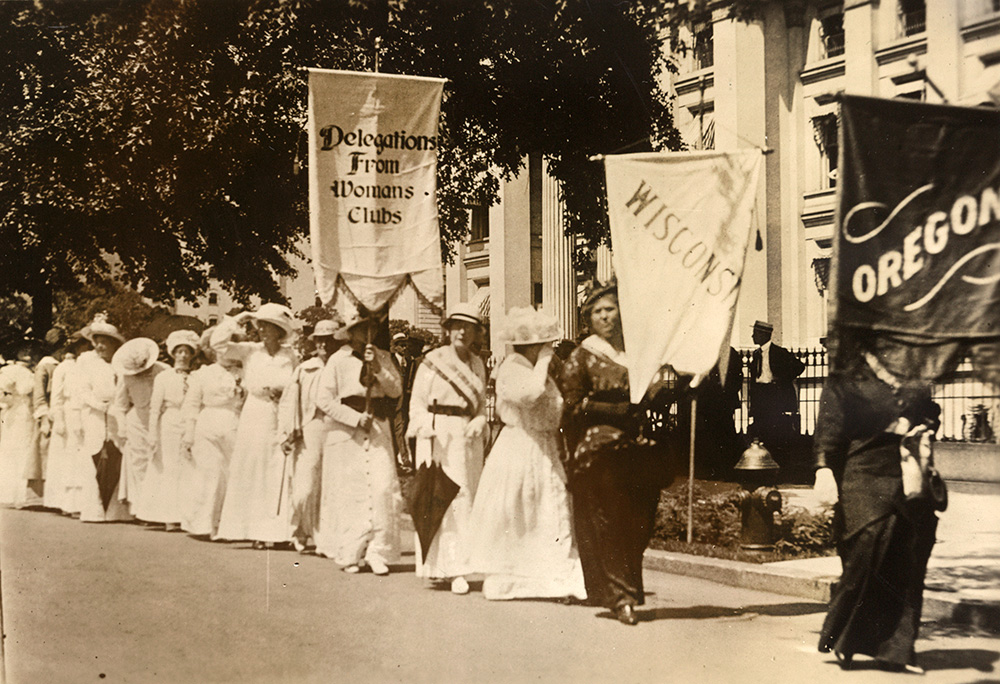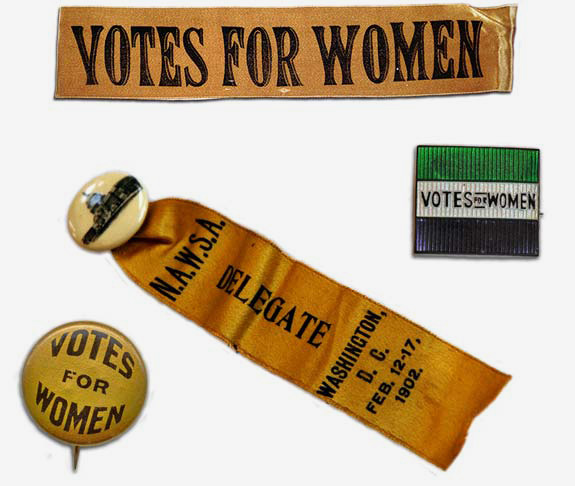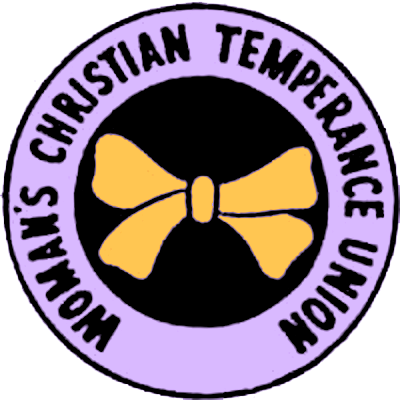
Delegations of women's clubs and organizations converge on Washington, D.C. for the first national suffrage parade in 1913. This photo shows the banner of the Oregon delegation. (Courtesy of Library of Congress) Enlarge Image
Delegations of women's clubs and organizations converge on Washington, D.C. for the first national suffrage parade in 1913. This photo shows the banner of the Oregon delegation. (Courtesy of Library of Congress) Enlarge Image A host of woman suffrage associations flourished from the late 19th to the early 20th centuries. Many disagreed on tactics and ideology, and often had acrimonious relationships with each other. They were all united on one front, however: that women suffered unjustly without access to the vote, and that action must be taken.
American Equal Rights Association; 1866-1869
The AERA was founded after the Civil War to advance the rights of all, especially women and African Americans. The coalition of women and abolitionists broke over disagreements on the nascent 15th Amendment. Some believed that enfranchising African American men was a necessary first step in the fight for universal suffrage. Others disagreed, arguing that the amendment should be scrapped in favor of a more inclusive bill, or even that voting rights be granted to white women before black men.
American Woman Suffrage Association; 1869-1890
Created following the American Equal Rights Association’s schism, the AWSA was a conservative women’s rights organization. It was a single-issue group focused only on obtaining suffrage for women and ignored other movements for gender equality. It promoted state campaigns for voting rights, and supported traditional social institutions like gender roles. Nonconfrontational, the AWSA playbook made appeals to men in power through petitions, testimony, and moving oratory.
Colored Women’s Equal Suffrage League; 1912
African American women in Oregon mobilized in preparation for the 1912 election. The CWESL was made up of members from Portland’s five African American churches, and run by Harriet (Hattie) Redmond and Katherine Gray. The group held meetings to raise awareness of voting rights issues in their communities, and gained the endorsement of Portland’s African American newspaper,
The Advocate. The CWESL also worked alongside Oregon’s white suffragists, a collaboration vital to the success of the 1912 campaign.
Congressional Union for Woman Suffrage; 1913-1917
Formed as a militant body inside the National American Women Suffrage Association by women who took a more aggressive approach to obtaining their rights. Headed by Alice Paul and Lucy Burns, the CUWS was singularly focused on the passage of the 19th Amendment. They led their organization to stage demonstrations and picket the White House.
Everybody’s Equal Suffrage League; 1912

Campaign items, including a National American Woman Suffrage Association button and ribbon, helped promote the cause. Gold or yellow served as the dominant symbolic color of the pro-suffrage movement. First adopted during a suffrage campaign in Kansas in 1867 to mimic the color of the state flower, the sunflower. Gold or yellow was often used together with white, green, or purple. NAWSA supplied packets of suffrage campaign material for states to use in their campaigns, which could include ribbons, pennants, and suffrage literature. Top: Votes for Women ribbon (Courtesy of Library of Congress); Left: Votes for Women pin (Courtesy of Shanna Stevenson); Middle and Right: NAWSA ribbon and Votes for Women pin. (Courtesy of Schlesinger Library, Harvard University)
Campaign items, including a National American Woman Suffrage Association button and ribbon, helped promote the cause. Gold or yellow served as the dominant symbolic color of the pro-suffrage movement. First adopted during a suffrage campaign in Kansas in 1867 to mimic the color of the state flower, the sunflower. Gold or yellow was often used together with white, green, or purple. NAWSA supplied packets of suffrage campaign material for states to use in their campaigns, which could include ribbons, pennants, and suffrage literature. Top: Votes for Women ribbon (Courtesy of Library of Congress); Left: Votes for Women pin (Courtesy of Shanna Stevenson); Middle and Right: NAWSA ribbon and Votes for Women pin. (Courtesy of Schlesinger Library, Harvard University) This broad group was unique to Oregon, founded by Esther Pohl Lovejoy as a force of inclusivity. Most suffrage organizations appealed to a narrow audience, defined by race, sex, or class. The EESL, by contrast, crossed those barriers and used the strength provided by this diversity to influence wide swaths of the electorate in Oregon’s pivotal 1912 vote.
International Alliance of Women/Alliance Internationale des Femmes; 1904-Present
Founded in Berlin by notable international suffragists including Americans Susan B. Anthony and Carrie Chapman Catt. The IAW promotes women’s rights as human rights, focusing on female empowerment and gender equality around the world. The group has general consultative status with the United Nations, and is involved with a number of national governments and international leagues.
League of Women Voters; 1920-Present
A few months before the ratification of the 19th Amendment, a confident NAWSA transformed into the League. The LWV sought to educate the growing number of America’s newly enfranchised women on the responsibilities of voting. Operating to this day, the League continues to bring awareness to women’s issues and works to keep women voting in the U.S. The LWV does not endorse or oppose candidates or parties, though in keeping with its roots the League actively supports a wide variety of progressive policies as feminist issues.
National American Woman Suffrage Association; 1890-1920
 This 1910 banner includes the motto of the National Association of Colored Women’s Clubs and colors that represented the suffrage movement. (Courtesy of Smithsonian National Museum of African American History and Culture)
This 1910 banner includes the motto of the National Association of Colored Women’s Clubs and colors that represented the suffrage movement. (Courtesy of Smithsonian National Museum of African American History and Culture) The AWSA and NWSA put aside their differences and merged after 21 years of separation. Run by Susan B. Anthony, Carrie Chapman Catt, and Anna Howard Shaw, the NAWSA grew from roughly 7,000 members to over two million, becoming the largest voluntary organization in the U.S. Though the group promoted women’s rights in general, it was primarily devoted to securing an amendment for woman suffrage. NAWSA began exerting political pressure on the U.S. Congress in the early 20th century as states enshrined voting rights for women.
National Association of Colored Women’s Clubs; 1904-Present
Drawn together from numerous African-American women’s organizations, the NACWC worked to enfranchise black women, as well as provide job training, equal pay, and child welfare. In the mid-20th century, it focused on ending segregation and lynching, and succeed in advancing integration of schools and businesses. It thrives today, continuing to work for the social welfare of African American women, children, and families.
National Council of Jewish Women; 1893-Present
A wide-reaching progressive organization, the NCJW has fought for human rights in the U.S. and abroad for over a century. Originally formed to aid Jewish women and immigrants in the U.S., the NCJW grew into a force for woman suffrage, social justice, education, community service, as well as advocacy for women and children worldwide. Today the NCJW focuses heavily on women’s economic and reproductive rights, as well as preventing domestic and sexual violence.
National Woman’s Party; 1916-Present
The NWP grew from and then eclipsed the Congressional Union for Woman Suffrage. Emerging at the outset of World War I, the NWP was a pacifist organization which opposed American involvement in the war. Their most famous figures were the Silent Sentinels who were repeatedly arrested and jailed for holding daily demonstrations in front of the White House. After the passage of the 19th Amendment the party continued to fight for women’s equality in the U.S., notably struggling to secure passage of another bill: the Equal Rights Amendment.
National Woman Suffrage Association; 1869-1890
 The colorized logo of the Woman's Christian Temperance Union [WCTU] from a 1920 temperance flyer. (Courtesy of Wikimedia Commons)
The colorized logo of the Woman's Christian Temperance Union [WCTU] from a 1920 temperance flyer. (Courtesy of Wikimedia Commons) The NWSA was a more militant women’s rights group that emerged from the demise of the American Equal Rights Association. Headed by Susan B. Anthony and Elizabeth Cady Stanton, it was an entirely female-led organization. More radical than its sister organization, the American Woman Suffrage Association, the NWSA promoted an array of women’s issues from their headquarters in New York City and Washington D.C. They used litigation to advance their agenda, and promoted the individual liberties of U.S. women as equal to those of men.
Woman’s Christian Temperance Union; 1873-Present
An evangelical Protestant organization, the WCTU advanced women’s rights as an extension of its core campaign against drugs and alcohol. The organization viewed women as morally superior to men, and believed women needed suffrage to protect their families from social ills. Unlike other suffrage groups, the WCTU did not promote radical agendas and was viewed by many conservative Americans as a more traditionally acceptable form of women’s politics. At its peak in 1927, the WCTU operated in over 40 countries and had over 700,000 members.
Women’s Trade Union League; 1903-1950
The WTUL was one of the first organizations to meld women’s rights with worker’s rights as more women entered the workforce in the early 20th century. The group worked closely with unions and the American Federation of Labor pushing support for woman suffrage among the working class. The WTUL saw the vote as a way for women workers to gain protective legislation and provide themselves with political equality.
Next:
Leaders >